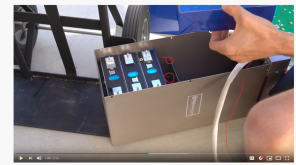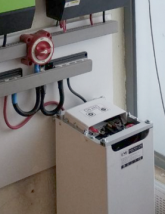I told them today that it confused me that my pack didn't leak for a month. I didn't touch it. Then it started leaking out of the blue. That's why I took the packs off my site. I don't trust them. I agree with you guys.There's something else going on here. 11 cells out of 100,000 is 1 in 10,000. So we're supposed to believe that Will was that one guy in 10,000 to be unlucky? I'm sure Big Battery is desperate to put this problem behind them, but I predict something else is going to surface to explain why this happened to Will.
You are using an out of date browser. It may not display this or other websites correctly.
You should upgrade or use an alternative browser.
You should upgrade or use an alternative browser.
Leaking Electrolyte from Bigbattery Powerblock
- Thread starter Will Prowse
- Start date
I am not certain how often this happens, but if you short the case to a voltage potential higher than the positive terminal the case may start to corrode/dissolve into the electrolyte. I don't know how long this would take to compromise the case (weeks?). This is why one should put a bit of separator between cells.
I would be curious if any of the leaking cells had conductive contact with a metal frame or the metal case of adjacent cells. Disassembled cells would show pitting and discoloration internally if this was the leakage cause.
I would be curious if any of the leaking cells had conductive contact with a metal frame or the metal case of adjacent cells. Disassembled cells would show pitting and discoloration internally if this was the leakage cause.
SteveDashH
New Member
- Joined
- Jan 20, 2021
- Messages
- 3
Were you using the battery during this month? Or was it just sitting idly in storage?I told them today that it confused me that my pack didn't leak for a month. I didn't touch it. Then it started leaking out of the blue. That's why I took the packs off my site. I don't trust them. I agree with you guys.
DerpsyDoodler
Solar Addict
- Joined
- Jan 10, 2021
- Messages
- 2,246
Have they asked you to return the damaged cell? If they do, would you?I told them today that it confused me that my pack didn't leak for a month. I didn't touch it. Then it started leaking out of the blue. That's why I took the packs off my site. I don't trust them. I agree with you guys.
Have you done a close examination of the cells to see if you can locate where it is leaking from? I don't trust that BB would be transparent about the issue. I know a lot of people have purchases these types of cells, and am wondering if there is a weakness with them that could be identified so those who have these cells can make them as safe as possible.
Aaron_85
New Member
Are these screws/rivets flush? If not not the bottom of the battery above may wear through its case, and if the bottom 4 is a tight friction fit, will wear the top of that cell too.
If there is any voltage potential between the cells case and terminals this wont end well either once it wears through the sleeve too.

If there is any voltage potential between the cells case and terminals this wont end well either once it wears through the sleeve too.

Is that pack casing bare metal? Those cells shouldn't be placed directly in contact with metal, the blue covering is too thin, and will wear through eventually.
Those spot welds on the divider could be trouble if there isn't a spacer pad on the end.
Those spot welds on the divider could be trouble if there isn't a spacer pad on the end.
Is that pack casing bare metal? Those cells shouldn't be placed directly in contact with metal, the blue covering is too thin, and will wear through eventually.
Those spot welds on the divider could be trouble if there isn't a spacer pad on the end.
C’mon, it’s not like they’re making this up as they go along?
Wait a minute ?
Good points guys. I am going to send this to them.
Hedges
I See Electromagnetic Fields!
- Joined
- Mar 28, 2020
- Messages
- 21,808
C’mon, it’s not like they’re making this up as they go along?
Wait a minute ?
Should we rename Will "Beta-test Bill"?
(Clearly not a smart move by vendor if that's happening. They ought to be cherry-picking what they give a reviewer.)
People who like tech products, people who like laws, and people who like sausages, shouldn't watch them being made.
I told them today that it confused me that my pack didn't leak for a month. I didn't touch it. Then it started leaking out of the blue. That's why I took the packs off my site. I don't trust them. I agree with you guys.
I spoke with BigBattery just a bit ago and they told me that they just shipped that 24V battery to Will this week. I asked because I wanted to know if this has been a slow failure over time. They said that it was either shipping damage from the factory (QA check didn't catch it before battery assy) or that the UPS guy might have damaged it delivering it.
Will, was this the battery you did the previous review with or did they ship you a different one?
I also spoke with BattleBorn and they shared that they have a new 270AH GC2 battery coming out next month. Same cylindrical cells just more of them. I'm sure it's going to be pricey. One benefit of the small cell design is that when one fails there isn't as much electrolyte to leak out. A sealed plastic case also means it's not going anywhere.
I was going to go with the 24V from BigBattery but now I'm not so sure. My installation would require them to be lying flat vs vertical so maybe it would be fine. At least it's a known issue now which means that they can correct it.
These UL listed batteries all seem to have plastic cases. Is the problem the metal case?
Sillyputty
Solar Enthusiast
- Joined
- Jul 21, 2020
- Messages
- 188
I spoke with BigBattery just a bit ago and they told me that they just shipped that 24V battery to Will this week.
This is what Will mentioned earlier in the thread:
"I told them today that it confused me that my pack didn't leak for a month." - https://diysolarforum.com/threads/leaking-electrolyte-from-bigbattery-powerblock.18439/post-214021
DerpsyDoodler
Solar Addict
- Joined
- Jan 10, 2021
- Messages
- 2,246
I don’t like the idea of cherry-picking. The reviewer would never experience something like what any of his base might. If I am going to make a recommendation on something, that is something I would be thinking about.Should we rename Will "Beta-test Bill"?
(Clearly not a smart move by vendor if that's happening. They ought to be cherry-picking what they give a reviewer.)
People who like tech products, people who like laws, and people who like sausages, shouldn't watch them being made.
Hedges
I See Electromagnetic Fields!
- Joined
- Mar 28, 2020
- Messages
- 21,808
I don’t like the idea of cherry-picking. The reviewer would never experience something like what any of his base might. If I am going to make a recommendation on something, that is something I would be thinking about.
Agreed. Some reviewers (Consumer Reports) claim they buy samples on the market to avoid that.
If any company is going to send a product to a known reviewer, do you believe they won't cherry pick?
For their own internal quality control (if they have that), would be more likely to randomly select (if not trying to please bosses.)
Bob B
Emperor Of Solar
- Joined
- Sep 21, 2019
- Messages
- 9,373
Just my luck as always. I contacted poison control and they think I will be fine. No symptoms so far.
I am pretty sure it is due to cell configuration. 92 pounds of cells stacked in this manner does not seem like a good idea. Second to bottom cell has gas inside and you can hear the electrolyte sloshing around.
I would love to hear your thoughts.
I really doubt that it is the weight of the cells that is the problem .... If you have followed any of the pack compression threads, the recommended pressure is over 600 Lbs to get 12 PSI.
Maybe it is the weight + side orientation? Maybe the side down orientation is not a good idea for these cells?... and it would seem to be even worse if they were jostling in a mobile application.
Aaron_85
New Member
TBH relying on only the thin plastic sleeve that is around the cells as the only seperator between it and a metal case is a pretty daft and game move on their behalf. If installed in anything that ever moves it's gonna do this eventually.Is that pack casing bare metal? Those cells shouldn't be placed directly in contact with metal, the blue covering is too thin, and will wear through eventually.
Those spot welds on the divider could be trouble if there isn't a spacer pad on the end.
The SOKs are metal as well although they are working on a plastic case “marine” battery.
The prismatic cells in the Lion Energy have the same blue wrap but as I recall from the tear down they have an air gap between the cells and the plastic case.
The BigBattery and the SOK batteries almost have an interference fit which I thought might be a good thing from all the comments on the compression threads.
The prismatic cells in the Lion Energy have the same blue wrap but as I recall from the tear down they have an air gap between the cells and the plastic case.
The BigBattery and the SOK batteries almost have an interference fit which I thought might be a good thing from all the comments on the compression threads.
mrdavvv
Solar Enthusiast
- Joined
- Jan 14, 2020
- Messages
- 405
The weight of a few cells stacked on each other is only 10% of the 700 lbs force applied with springs to achieve 12 psi.
Maybe it is the weight + side orientation? Maybe the side down orientation is not a good idea for these cells?... and it would seem to be even worse if they were jostling in a mobile application
Yes that's a good observation... im also not so sure about weight being the problem, probably more related with the orientation?.
Something bad happened to the battery, it couldn't vent because of the side position, and then the electrolyte just burst trough the safety valve (Or where it could)... at least thats my theory. The little documentation that i saw against that positioning was exactly for this reason.
I have much heavier cells (280AH) with the same design, they are working ok, and not signs of the bottom one deforming or anything. After this documented case of toxic liquid coming out of the batteries, im putting my batteries straight to the floor

---
Also, if i was Bigbattery, and i wasn't so sure about my quality department... the last person i would like to send samples or promote products would be Will
HighTechLab
AKA Dexter - CTO of Current Connected, LLC
- Joined
- Sep 23, 2019
- Messages
- 1,754
I just took an aluminum case cell and measured voltage from negative terminal to the case - 3.2v.
So I put my meter into ohms mode and checked between + terminal and the case - 110 ohms.
Based on ohms law, let's say worst scenario we had somehow gotten 20v potential on the case because cell 1 + is connected to cell 8 case, now we have 3.6 watts of power doing something. My theory is that it is reacting with the aluminum case and causing pitting. Over the course of a month, that could mean a hole in the case.
I sell batteries, similar to the ones in the 24v powerblock from BigBattery, and I am considering revising my manual to recommend a plastic separator between each cell. I am no longer convinced that the thin film on the cases is good enough for insulation, even though the connection between the case and the positive terminal is a really high resistance. I am tempted to do some more destructive testing on cells - apply voltage from the + terminal to the case and see what happens over time. Will it cause pitting and a pinhole to form? Might be a very interesting test and video to make and share with the community.
So I put my meter into ohms mode and checked between + terminal and the case - 110 ohms.
Based on ohms law, let's say worst scenario we had somehow gotten 20v potential on the case because cell 1 + is connected to cell 8 case, now we have 3.6 watts of power doing something. My theory is that it is reacting with the aluminum case and causing pitting. Over the course of a month, that could mean a hole in the case.
I sell batteries, similar to the ones in the 24v powerblock from BigBattery, and I am considering revising my manual to recommend a plastic separator between each cell. I am no longer convinced that the thin film on the cases is good enough for insulation, even though the connection between the case and the positive terminal is a really high resistance. I am tempted to do some more destructive testing on cells - apply voltage from the + terminal to the case and see what happens over time. Will it cause pitting and a pinhole to form? Might be a very interesting test and video to make and share with the community.
Hedges
I See Electromagnetic Fields!
- Joined
- Mar 28, 2020
- Messages
- 21,808
See "LiFePO4 Battery Autopsy/Teardown" on Youtube. The adventurous gentleman disassembles failed pouch cells. Safe? Good question. Here's a safety data sheet. Seems to me, pretty mild stuff. Gloves, respirator and safety glasses? Maybe not even respirator? Dunno. I certainly don't want to encourage anybody to do anything unsafe, but it sure would be interesting to know what's inside. Jelly roll? Accordion folds? Pouches? And how does the internal construction relate to failure rates, thermal characteristics, capacity. Etc.
I don't know, is it stupid to make a habit of dissecting failed cells? After full discharge maybe?
(edit) OK, I learned that the cathode is 5% polyvinylidene fluoride, which in itself is non-toxic. According to the above safety data link, hydrogen flouride can be formed if water gets into the cell. So under normal circumstances, seems like not a risk. But things that smell really bad...
And caveat: don't rely on my word in regard to health risks. We do keep telling ourselves that the lifepo4 chemistry is nontoxic, but that has to be critically examined.
I don't know, is it stupid to make a habit of dissecting failed cells? After full discharge maybe?
(edit) OK, I learned that the cathode is 5% polyvinylidene fluoride, which in itself is non-toxic. According to the above safety data link, hydrogen flouride can be formed if water gets into the cell. So under normal circumstances, seems like not a risk. But things that smell really bad...
And caveat: don't rely on my word in regard to health risks. We do keep telling ourselves that the lifepo4 chemistry is nontoxic, but that has to be critically examined.
Last edited:
I've been obsessing over that question for a while for my own battery case design. Maybe plastic washers or strips between the cells to allow some airflow? We really don't know much about the thermal characteristics of tightly packed prismatic cells, do we. This would be more or less the opposite of compression. I'm not convinced that compression does anything useful, but like you, I'm really leery about that flimsy plastic sheet between charged, conductive surfaces.I am considering revising my manual to recommend a plastic separator between each cell.
Sure hope ours never leak!hrm... I wonder what battleborn is thinking about all this
It means something to me: the question of whether there is any acceptable orientation other than upright is entirely settled, in the negative.Many of us who have EVE cells can hear electrolyte sloshing around in the cells. I am not sure that means anything.
Similar threads
- Replies
- 14
- Views
- 770
- Replies
- 4
- Views
- 3K



